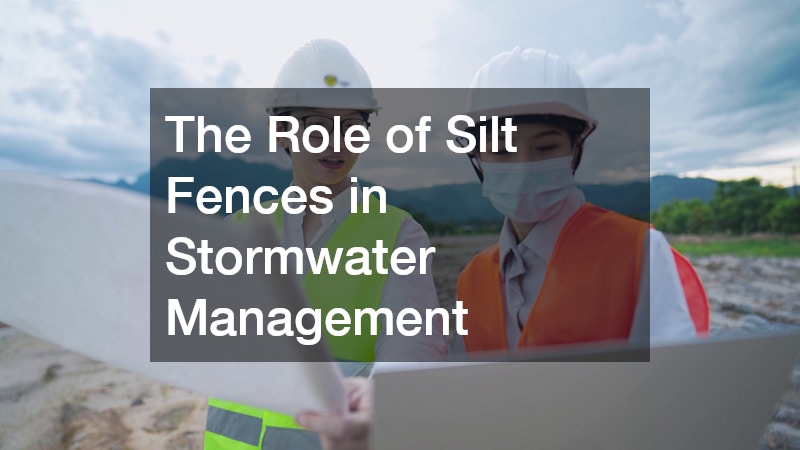
The Role of Silt Fences in Stormwater Management
Managing stormwater effectively is a critical component of environmental conservation, infrastructure planning, and urban development. With increasing construction activities, preventing sediment runoff and erosion has become a significant challenge for environmental management. Silt fences are indispensable tools that play a pivotal role in controlling sediment runoff, especially during construction activities where land disturbance is prevalent.
The Basic Principles of Silt Fences
Silt fences function by acting as a physical barrier to sediment, intercepting and slowing down surface water to allow soil particles to settle. These fences are typically made of durable geotextile fabrics, which are anchored to support posts, forming a temporary barrier that filters sediment while permitting water passage.
By capturing sediment onsite, they prevent sediment-laden runoff from reaching stormwater systems, streams, and rivers.
Effectively managing sediment control is crucial for protecting water quality and aquatic ecosystems. Silt fences are employed on construction sites to comply with environmental regulations that limit the amount of sediment that can be transported off-site. The design of silt fences is deliberately simple, utilizing tension and gravity to ensure optimal stability and filtration capacity, which is essential for their functionality and ease of installation.
The use of silt fences also provides construction site managers with a cost-effective solution, lowering the potential fines associated with transgressing erosion control guidelines. Silt fences usually serve as the first line of defense in a broader erosion control strategy, effectively preserving topsoil which would otherwise degrade the surrounding environment if displaced. Thus, the strategic use of silt fences serves both ecological and economic interests for developers.
Installation Best Practices
Proper installation of silt fences involves a comprehensive site assessment to determine suitable locations that maximize efficiency while minimizing environmental impacts. Placement strategies require careful consideration to ensure that the fence is integrated into the natural landscape of the area, forming a continuous approach that follows the contour of the terrain. Avoiding common mistakes during installation is critical, including ensuring fabric tension is adequate and preventing gaps at the bottom of the fabric barrier.
Silt fence installation typically involves burying the bottom portion of the fabric to prevent underflow, often with a trench dug at a minimum of six inches deep. A poorly installed silt fence can lead to underperformance, potentially allowing significant amounts of sediment to bypass the barrier. Regular inspections and maintenance are essential to ensure the integrity and functionality of the fence, especially after severe weather events.
Materials Used in Silt Fences
Types of Fabrics and Their Pros and Cons
Woven and non-woven geotextiles are the primary materials used in the construction of silt fences, each offering distinct advantages and disadvantages. Woven fabrics are generally more durable and resistant to UV degradation, making them suitable for projects with longer timelines. However, they typically offer less filtration efficiency compared to non-woven fabrics, which provide better permeability but are susceptible to tearing and may require more frequent replacement.
The choice between woven and non-woven geotextiles should be informed by site-specific conditions, such as expected duration of the project, environmental factors, and budget. Woven geotextiles oftentimes require tighter tensioning given their reduced flexibility and are more labor-intensive to install. Non-woven fabrics, while providing superior filtration, can saturate and clog more quickly under heavy sediment conditions, necessitating frequent inspections and maintenance.
Environmental Considerations
Choosing eco-friendly silt fence materials and employing sustainable practices reflect a broader trend toward environmentally responsible construction methods. Advances in textile engineering have introduced silt fence fabrics that are biodegradable, offering a balance between environmental impact and performance. These products decompose naturally over time, reducing the waste generated from construction activities.
Commitment to sustainable environmental considerations also means evaluating the lifecycle impacts of silt fence materials, from production through disposal. Builders and developers must weigh the ecological benefits of biodegradable options against characteristics such as durability and cost. The integration of sustainable practices in sediment control measures is a pivotal aspect of reducing the overall ecological footprint of construction projects.
Why Are Silt Fences Important for Construction Sites?
Regulatory Compliance
The importance of silt fences is underscored by strict regulatory requirements mandating sediment control measures on construction sites. Compliance with these guidelines is vital to prevent sediment pollution and protect aquatic ecosystems from degradation. Regulatory standards often prescribe specific installation and maintenance requirements for silt fences, necessitating diligent adherence to avoid penalties and project delays.
Federal, state, and local environmental regulations commonly include provisions related to stormwater management, such as the National Pollutant Discharge Elimination System (NPDES) in the United States. Non-compliance with these regulations can result in significant financial penalties and reputational damage for construction firms. Integrating silt fences into erosion control plans aids developers in meeting both the letter and spirit of such environmental laws.
Impact on Site Safety and Environment
Silt fences significantly enhance site safety by reducing potential hazards associated with sediment-laden runoff, such as slippery surfaces and impaired visibility. By capturing sediment onsite, they mitigate risks that can harm workers and the surrounding community, ensuring secure and efficient construction operations. Furthermore, they assist in maintaining the integrity of access roads and pathways, reducing maintenance needs.
Environmentally, silt fences play a crucial role in preserving nearby aquatic ecosystems by limiting sediment runoff, which can affect water quality and habitat health. This preventative measure helps maintain the biodiversity and functionality of aquatic environments, which can be adversely impacted by excessive sedimentation. The presence of silt fences buffers the effects of construction on water bodies, enabling ecological resilience.
Silt fences are vital components of stormwater management strategies, offering an effective barrier against sediment runoff and erosion during construction projects. Through a combination of efficient design, best installation practices, and the utilization of suitable materials, silt fences significantly contribute to environmental conservation and regulatory compliance. As we advance, research and development into innovative, more sustainable erosion control solutions will further solidify the role of silt fences as essential tools in the dynamic field of stormwater management.
.


